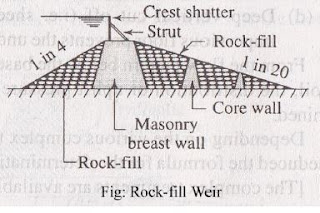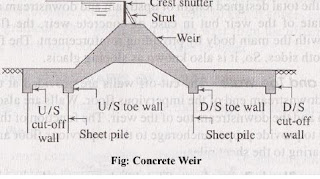Diversion Head Works
The works, which are constructed at the head of the canal, in order to divert the river water towards the canal, so as to ensure a regulated continuous supply of silt-free water with a certain minimum head into the canal, is known as diversion heads works.
The objective of Diversion Head Works
To raise the water level at the head of the canal.
To form storage by constructing dykes (embankments) on both the banks of the river so that water is available throughout the year
To control the entry of silt into the canal and to control the deposition of silt at the head of the canal
To control the fluctuation of water level in the river during different seasons
Selection of Site for Diversion Head Works
At the site, the river should be straight and narrow
The river banks should be well defined.
The valuable land should not be submerged when the weir or barrage is constructed.
The elevation of the site should be much higher than the area to be irrigated.
The site should be easily accessible by roads or railways.
The materials of construction should be available in the vicinity of the site.
The site should not be far away from the command area of the project, to avoid transmission loss.
Weir and Barrage
It is a barrier constructed across the river to raise the water level on the upstream side of the obstruction in order to feed the main canal.
The ponding of water can be achieved either only by a raised crest across the river or by a raised crest supplemented by gates or shutters, working over the crest.
 |
| Weir and Barrage |
Weir
If the major part of the entire ponding of water is achieved by a raised crest and a smaller part or nil part of it is achieved by the shutters, then this barrier is known as a weir.
 |
| A typical cross-section of a modern concrete weir |
Gravity and Non-gravity weirs:
When the weight of the weir (i.e. its body and floor) balances the uplift pressure caused by the head of the water seeping below the weir, it is called a gravity weir. On the other hand, if the weir floor is designed continuously with the divided piers as reinforced structure, such that the weight of the concrete slab together with the weight of divided piers keep the structure safe against the uplift then the structure may be called a non-gravity weir.
o In the latter case, RCC is to be used in place of brick piers
o Considerable savings may be obtained, as the weight of the floor can be much less than what is required in gravity weir.
Types of weirs
(a) Masonry weirs with a vertical drop
(b) Rock-fill weirs with sloping aprons
(c) Concrete weirs with sloping glacis
Masonry weirs with a vertical drop
Masonry weir wall is constructed over the impervious floor. Cut-off walls are provided at both ends
of the floor. Sheet piles are provided below the cut-off walls. The crest shutters are provided to raise the
water level if required. The shutters are dropped down during flood. The masonry weir wall may be
vertical on both faces or sloping on both faces or vertical on the downstream faces and sloping in upstream faces.
 |
| Masonry weir |
Rock-fill weirs with sloping aprons
 |
| Rock-fill weirs |
Concrete weir
 |
| Concrete weir |
Barrage
 |
| A typical cross-section of a barrage |
Afflux:
The choice between a weir and a barrage
Difference between Barrage and Weir
|
SL |
Barrage |
Weir |
|
1 |
Low set crest |
High set crest |
|
2 |
Ponding is done by means of gates |
Ponding
is done against the raised crest or partly against crest and partly by shutters |
|
3 |
Gated over entire length |
Shutters in part length |
|
4 |
Gates are of greater height |
Shutters are of smaller height, 2 m |
|
5 |
Gates are raised clear off the high floods to pass floods |
Shutters are dropped to pass floods |
|
6 |
Perfect control on river flow |
No control of river in low floods |
|
7 |
Gates convenient to operate |
Operation
of shutters is slow, involve labor and time |
|
8 |
High floods can be passed with minimum afflux |
Excessive afflux in high floods |
|
9 |
Less silting upstream due to low set crest |
Raised crest causes silting upstream |
|
10 |
Longer construction period |
Shorter construction period |
|
11 |
Silt removal is done through under sluices |
No means for silt disposal |
|
12 |
Road and/or rail bridge can be constructed at low cost |
Not possible to provide road-rail bridge |
|
13 |
Costly structure |
Relatively cheaper structure |






No comments:
Post a Comment
If you are getting more information from civilengineerfriend page please give your comments. Share the page information in your whatsapp group. Subscribe our page to get more information.